Feb 8, 2019Athletic training lessons: A passion for learning
 The athletic trainer lives a hectic schedule. Many daily responsibilities and obligations of an athletic trainer leave precious little time for growth as a professional. Even though there are numerous educational opportunities for growth, many athletic trainers are not inclined to continue their education beyond meeting BOC requirements for CEUs.
The athletic trainer lives a hectic schedule. Many daily responsibilities and obligations of an athletic trainer leave precious little time for growth as a professional. Even though there are numerous educational opportunities for growth, many athletic trainers are not inclined to continue their education beyond meeting BOC requirements for CEUs.
What is the impetus to growth for the athletic trainer? A quote from Anthony J. DeAngelo addresses this question: “Develop a passion for learning. If you do, you will never cease to grow.” I have been committed to continuous growth through learning, and have observed many other athletic training colleagues who continue to learn and grow in order to contribute to the enhancement of the athletic training profession.
As an athletic training student at Ohio University, I developed a commitment for continuous learning and growth throughout my career. My academic mentor at Ohio University, the late Dr. Fredrick “Fritz” Hagerman, instilled a passion for learning early in my academic life at Ohio University. Dr. Hagerman’s insights on learning content at a high level and to critically think through situations were some of the most valuable lessons I could have received. Dr. Hagerman and I would routinely discuss learning strategies and future areas of content in athletic training.
Being an Ohio University dean’s achievement scholar, and tapped for Omicron Delta Kappa (for scholarship achievement) were a result of Dr. Hagerman’s influence and sponsorship. Coupling Dr. Hagerman’s influence on continuous learning with the great mentorship of Skip Vosler, Ken Rusche, and Ken Wright, I was able to grow as a young professional entering athletic training.
» ALSO SEE: All Ears: Professional development for athletic trainers
My commitment to continuous growth and learning assisted me in maximizing my graduate assistantship experience at Syracuse University. Don Lowe, my mentor at SU, strongly believed in advancing one’s knowledge and skills to provide care to student-athletes at a high level. He held regular presentations by local and team physicians early in the morning on the presenter’s area of expertise. Learning the intricacies of evaluation and decision-making continuums in evaluation and care from these various physicians added greatly to my assessment acumen.
I invariably read further on topics presented at those meetings by going to the local Upstate Medical School library (yes, it was the early 1980s before the Internet) to enhance my understanding of an injury or medical condition. Throughout my career, I have sought training in numerous areas, and have encouraged colleagues, athletic training students, and graduate assistants to do the same.
Learning new information can also sometimes save lives. I had gone to several talks on the value of AEDs in 2000, and started doing some research on this new concept. In August 2001, I was able to convince athletic administration (through information from those meetings and studies I cited) of the value of having AEDs on the sideline to quickly access in the event of a sudden cardiac arrest. Jake Crouthamel, the SU director of athletics at the time, approved additional purchases beyond the general sports medicine department budget to obtain several AED units. Less than eight weeks later, on September 29, 2001, the life of Conference USA official Gerry Bram was saved with the use of an AED during the Syracuse University-East Carolina game in the Carrier Dome.
My work in the area of behavioral health is an outgrowth of studying this growing concern in student-athletes in the literature and attending mental health disorders conferences. This is an area that most athletic trainers would not normally delve into.
The athletic training profession has many examples of how to grow and to contribute to the growth of the profession. Examples of this can be found in the work of Ron Courson at the University of Georgia, in the areas of MRSA control, emergency action planning, cardiac emergency care, and spine-injured athletes, just to name several of the many contributions he has made in knowledge and skills to the athletic training profession. Another professional expert is Charlie Thompson at Princeton University. His work in sports medicine administration, documentation, and medical model reporting lines has assisted the profession in the methodology of delivering care.
To grow in this profession, gaining content knowledge in class and developing your skills is not enough. Another area for growth is interacting with experts. I suggest going up to presenters following a talk, or writing to an expert with questions regarding their insights and emerging trends. For the athletic training student or young certified athletic trainer, this can be somewhat intimidating. Get out of your comfort zone and go up to an expert, introduce yourself, ask a question, and see if the expert will correspond with you regarding further questions. Ask for their email address. You will be pleasantly surprised how most experts are willing to help out the next generation of professionals. Growing through personal insights is a valuable tool, something I experienced at Ohio University with Dr. Hagerman, and with each of my mentors and many colleagues with whom I keep in touch.
The athletic trainer should develop a passion for learning and apply it to the many areas of their profession. This will help you be a more effective athletic trainer in many ways.



